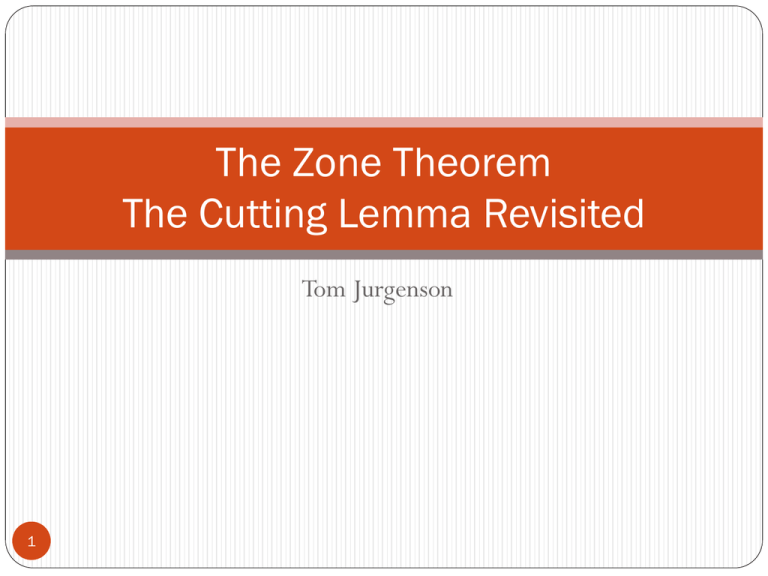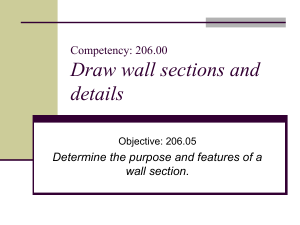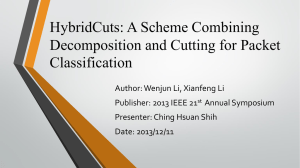Slides
advertisement

The Zone Theorem The Cutting Lemma Revisited Tom Jurgenson 1 The Zone Theorem 2 Definitions reminders Is a sub-space of d-1 dimensions. Is a partition of into relatively open convex sets. Are 0/1/(d-1)-dimension faces (respectively) in Are the connected components of 3 . also called d-faces Example d=2 (Plane) Vertices are points, edges are segments, and facets are also segments since 2-1=1. Cells are 2-dimesional connected components in The blue lines are the Hyperplanes in H Their arrangement creates: Vertices – in red Edges\Facets – blue segments(excluding red) Cells – light blue areas. 4 The Zone Theorem - Motivation Motivation – we would like to bound the number of faces that can see any part of a given hyperplane. For that we’ll need to define what ‘see’ means, and define the set of objects (faces) that ‘see’ g (the zone). 5 Definition for ‘sees’ A face F can see hyperplane g of H (set of hyperplanes), if there are points such that the open segment xy does not intersect any hyperplane of H. Important Note: It does not matter which point x we choose, either all of them can see g or none can. In this example, the red line represents a segment between the thick line – g, and the face – the cell. The blue line exemplifies the fact that no segment connects that cell with the hyperplane g. 6 Zone Definition Zone – The zone of hyperplane g, is the set of the faces of the arrangement of H that can see g. Here is the zone (dark grey area) for hyperplane g (the thick line) and hyperplane set H (all the thin lines). Each face (vertex, edge and cell) in the zone of g can see g. 7 The Zone Theorem The number of faces in the zone of any hyperplane in an arrangement of n hyperplanes in is with the constant of proportionality depending on d. we will prove this theorem in an inductive manner 8 Base case, d=2 (The plane) Let H be a set of n lines in the plane in general position. We consider the zone of line g. In this case the faces would be: vertices (0-faces), edges (1faces), and the cells are convex polygons that may or may not be bounded(1-faces). The bound for the number of faces in the zone in this case should be 9 Bound for Edges is enough The number of vertices is proportional to the number of edges since in a convex polygon the number of vertices is equal to the number of edges. And in open cells, the number of edges is at most twice the number of vertices. It is clear that the number of polygons is bounded by the number of vertices by using Euler’s formula: F=v-e+2. Therefore proportional to the number of edges. 10 Bound for Edges Let g be a horizontal line. We’ll count the number of edges that see g that are also above g. The number of edges that intersect g that are also above g is bounded by n. Since each line (hyperplane in H) out of the n lines can only intersect g in one point. The other edges are disjoint from g, and in the next slides we are going to find a bound for these edges. 11 Bound for the disjoint edges Let uv be an edge that sees g but is disjoint from it. Let be the line containing uv. And let a be the intersection of g and h. Since u is a vertex - it is the intersection of two lines – so let be the other line that passes through u. Let b be the intersection of l and g. 12 Right Edge of Line l Definition: uv is right edge of l if b is on the right of a. uv is left edge of l if b is on the left of a. We’ll show that for each such there is at most one right edge. Let’s assume uv is a right edge for l. 13 Only one right edge Assume by contradiction that there are two right edges for l. Let uv and xy be the two right edges, and assume that uv lies below xy. By definition xy should see some point of g. However, every point to the left of a on g is obscured by the line l. And every point to the right of a on g is obscured by the line h. This contradiction shows that only one right edge can exist for each line. 14 Only one right edge (2) 15 Conclusion for d=2 Each line in H has at most one right edge, and by symmetry also at most one left edge. There is also an edge that intersects g. The same can be argued for edges below g, for the lower right and lower left edges, and an edge that intersects. Altogether there are at most 6 edges for each line in H in the zone. There are n lines in H so the number of edges is at most 6n. Linear in n. We already argued that the total number of faces is linear in the number of edges therefore the number of faces in the zone when d=2 is: as needed. 16 Inductive Step from d-1 to d Assume that the total number of faces of a zone in is Mark as the max. number of (d-1) faces in the zone in an arrangement of n hyperplanes in . Let H be an arrangement of hyperplanes and g a base hyperplane s.t is attained for them. 17 Motivation: number of blue facets We color one hyperplane in H red, let it be 18 . The rest n-1 hyperplanes in H we color blue. A Blue Facet is a facet that lies in a blue hyperplane. Since every facet has a chance of becoming blue (choose any blue hyperplane out of n blue hyperplanes), the expected number of blue facets is Now we bound the expected number of blue facets in a different way and use it to estimate Example in the next slide… Blue and Red Facets 19 Bound for Expected Blue Facets Consider the arrangement of blue hyperplanes only. Since there are n-1 such hyperplanes the number of blue facets is bounded by In the next stage we add the red hyperplane h and see how it affects the number of blue facets in the zone of g. 20 The increase in number of blue facets caused by h The red hyperplane h may split an existing blue facet F into two new facets – F1 and F2. If both new facets can see g then we get an increase in the number of facets. Claim: is visible from (we’ll prove it later) If we intersect all blue hyperplanes with g and with h we get a d-1 dimensional arrangement in which is a facet in a zone of the d-2 dimensional hyperplane . Using the induction assumption we get such “splits”. The total number of facets becomes: 21 Split Example 22 Proof for the above claim Reminder: We wanted to show the following claim: is visible from Proof: Let C be a cell of the zone in the arrangement of blue hyperplanes having F on the boundary. Because F1 and F2 see g we get that sees and sees The interior of is contained in C and we get that the intersection of with the hyperplane h contains a segment witnessing the visibility of from 23 Split Example (II) 24 Conclusion for facets On the one hand we calculated the expected number of blue facets: On the other hand we found an upper bound for the number of blue facets: We combine the two and get: 25 Conclusion for facets (II) And as we can see: as needed. Next we are going to discuss d-k faces and not just d-1 faces (or facets) 26 Expected number of d-k faces Denote 27 the max. possible number of j-faces in the zone for an arrangement of n hyperplanes of dimension d. Let H be an arrangement of n hyperplanes where is attained. Again a random hyperplane h in H is colored red and the rest blue. Reminder: a d-k face is the intersection of k hyperplanes. A d-k face is blue if its relative interior is disjoint from the red hyperplane h. Expected number of d-k faces (2) The probability for a d-k face to be blue is : [For the selection of first blue hyperplane, then the second on so on until we select the k-th hyperplane] As in the facet case we get that the expected number of blue d-k faces in the required zone is: 28 Upper bound for d-k faces By adding the red hyperplane h the number of blue d-k faces can increase by at most by the inductive hypothesis. Using the same arguments in lower dimensions as the facets case we get to the conclusion that: And in the next slide we’ll show: 29 Algebraic proof 30 Bound for edges and vertices For the case k=d-1 (edges) by using this method we only get the bound: So the number of edges and vertices must be bound separately: Vertices: Each vertex is contained in some3-face of the zone. Within such 3-face, the number of vertices is at most 3 times the number of 2-faces, because the 3-face is a 3D convex polyhedron. Since H is simple each 2-face is contained in a bounded number of 3-face. It follows that the total number of vertices is at most proportional to 31 Final details Edges are proportional to vertices. In conclusion, for every k=1…d-2 we get For vertices and edges we get In conclusion we get that the zone has 32 Zones in other arrangements The max. complexity of a zone can be investigated for objects other than hyperplanes, and that leads to many related problems that we won’t discuss here. 33 Cutting Lemma Revisited 34 General Plan First, we’ll prove the cutting lemma for the planar case with a tight bound. We already saw a proof for a bound that was not tight that uses random sampling, and a different proof that is tight but does not use random sampling. The following proof is both tight and uses random sampling in a way that makes it easy to be generalized to higher dimensions. But first we’ll do a review for some cutting-lemma related definitions. 35 Review of Definitions (I) A generalized triangle is the intersection of 3 half planes. A cutting of the plane into generalized triangles, is the subdivision of the plane to a disjoint set generalized triangles that their union covers the entire plane. 36 Review of Definitions (II) A cutting of the plane with a set of n of lines H – is a cutting of the plane into generalized triangles s.t the interior of each such is intersected by at most lines from H. Note – the triangles’ edges may or may not include lines from H. 37 ½ cutting example In the next example we have a ½ cutting. The red lines are lines in H, the black lines are the lines that create the triangulation. 38 The Cutting Lemma For every set H of n lines in the plane and every r>1 there exists a 1/r cutting for H the size In other words, there is a subdivision of the plane into generalized triangles s.t the interior of each triangle is intersected by at most n/r lines of H. 39 The sampler Goal – sample line. Once the lines are sampled their intersection (possibly with some modifications) would result in a triangulation. In the previous lecture when we wanted to select a subgroup S of H, we picked |S| lines out of H with repetitions. This procedure may result with a subgroup of size smaller than |S|. In order to simplify the calculation, we’ll choose S by independent Bernoulli trials. We fix the probability of p=s/n, and include a line from H in S using that probability. For this point on, let s=|S| 40 Why sampling and triangulation does not work? In a previous lecture we already saw a sampling algorithm that outputs a triangulation that with probability close to 1 non of the triangles in the outputted triangulation is intersected by more than where is some constant (Weak Cutting Lemma) We will demonstrate that a similar statement with a is not generally true. So our method would have to include more than just sampling in order to achieve the desired triangulation. To see that we’ll examine a simpler case than the plane – 1dimensional situation. 41 The 1-D case H is a set of n points. A generalized triangle in this case is the segment between two points. We would like to count the longest consecutive count of unselected points of H. Let k be our target number for such a count. In example below, n=30 and s=15 so p=0.5. The black dots are selected points (In this example there are exactly 15 selected dots, but it doesn’t have to be this way) 42 k consecutive unselected points We’ll show that for a fixed k it is very likely that k consecutive unselected points show up in a sequence of n points, where n is sufficiently large For simplicity assume n is divisible by k and divide our n points in to blocks the length of k. Notice that this is an even more restrictive case than a general consecutive count. In each such a block there is a probability of for the entire block to be unselected. Therefore the probability of not obtaining any block as entirely unselected is and this probability is exponentially small for k proportional to 43 Why is it exponentially small? p is a constant, let p=0.5. The probability becomes: Now set k=0.5logn: And that exponentially small as n goes to infinity. 44 Conclusion of 1D A sequence of k that is proportional to log of n is very likely to appear using this sampling method. This is why this method is not good enough to get the 1/r cutting we require. Of course, in the 1D case we can define a sampler that selects every n/s point. However it is not clear how to transform this selection to the plane (Where the lines are not ordered). 45 2nd attempt – Two level decomposition General plan: Instead of trying to improve the sampling algorithm to generate a 1/r cutting from the start: 1. we’ll take a random sample (obtained as before with probability p=s/n independent Bernoulli trials) 2. We just saw that this is not good enough, so we’ll take every triangle that intersects more lines than required and divide it so each new triangle will be good for our 1/r cutting. Finally, we’ll show that the total number of triangles is 46 But first, more definitions Let T be the collection of triangles after triangulating the random sample. Let denote the set of lines of H that intersect the triangle and number of lines that intersect. Let the excess of be Note: if so the triangle can be included in the 1/r cutting. If we subdivide it to a collection of finer triangles. 47 Subdivision of triangles with excess greater than 1 We consider the arrangement of (instead of H), and we construct a cutting for it. (How? We’ll see later...) We intersect this triangulation with . This process may produce triangles, but also quadrilaterals, pentagons, and hexagons. Each of these convex polygons is subdivided into triangles. Each triangle in the cutting is intersected by at most triangles, and therefore are valid for the 1/r cutting. 48 Example: Up – the process of subdividing a triangle with excess greater than 1. Left – An example for a hexagon created by combining the two triangulations. 49 But How? The suboptimal cutting lemma. As of now, we can’t subdivide because the cutting lemma is not valid yet. So let’s use a weaker claim: The Suboptimal Cutting Lemma for every finite collection of lines and any u>1, there exists a 1/u cutting consisting of at most: triangles, where K is a suitable constant. We’ll prove the suboptimal cutting lemma later. 50 Using the suboptimal cutting lemma If we use the suboptimal cutting lemma for producing the cuttings, we can estimate that the number of triangles in the 1/r cutting is bounded by: Note that we get one if the excess is less or equal to 1. If the excess is greater than 1 we get the bound of the yet unproven suboptimal cutting lemma times 4. The times 4 is for the triangulation of a possible hexagon as shown here: 51 Using the suboptimal cutting lemma (II) We have two goals now: 1. Prove the suboptimal cutting lemma. 2. Show that although we typically have triangles as large as about log(r) the expected number of triangles in T with excess t or larger decreases exponentially as a function of t. 52 We’ll prove the first claim by demonstrating a triangulation method that achieves that bound – the vertical decomposition (next slide). The second claim would be included in the proof of the Cutting Lemma. Vertical decomposition - reminder We erect vertical segments upwards and downwards from each vertex in the arrangement of S and extends them until they meet another line (or all the way to infinity) We get trapezoids, but those can be split into 2 triangles. Let Trpz(S) denote the set of generalized trapezoids in the vertical decomposition of S. 53 Proposition: Trapezoids with large excess are rare Proposition: Let H be a fixed set of n lines in general position, let p=r/n, where , let S be a random sample drawn from H by independent Bernoulli trials with success probability of p, and let be a real parameter. Let denote the set of trapezoids in with excess at least t Then the expected number of trapezoids in is bounded as follows: For a suitable constant C. 54 Notes for this proposition If r is not smaller than n/2 than we can easily find a cutting, as we saw in the cutting lemma lecture it’s only gets interesting when r is proportional to logn. Reminder: How to construct such a cutting? If r is proportional to n one can select all lines in the H, as shown before this creates the desired subdivision. We use this limitation to find a finer cutting only because this is needed in the proof of this proposition (but we’ll get there much later) 55 Proof of the suboptimal cutting lemma Set for a sufficiently large constant A. Assume that the trapezoid proposition holds – and choose a sample S accordingly. Activate the proposition twice – once for and once for 56 First case For by using the proposition: for some constant B. Also note that Finally: 57 Second case For by using the proposition: for some constant C. We’ll group the constants together: Since: there exists A large enough s.t 58 Proof of the Suboptimal Cutting Lemma – Conclusion From these two cases and the linearity of expectation we get: There exist a sample were both parts of the sum are smaller than 2/3. Notice that the second part is at least 1 and therefore 0. So there exists a sample S with both and 59 Proof of the Suboptimal Cutting Lemma – Conclusion (II) That means that there exists a 1/u cutting into triangles. Suboptimal Cutting Lemma proof is complete. 60 Proof of the Cutting Lemma (I) Reminder: To produce a 1/r cutting we pick a sample S with probability p=r/n as described before. We let T be the collection of triangles of the vertical decomposition of S (actually – trapezoids, but that has no effect). For every triangle t in T with excess greater than 1 we refine the triangulation with a cutting. We’ll estimate the expected number of triangles: 61 Proof of the Cutting Lemma (II) As and Since each part of the sum is at least 1. Also group by order 62 ‘s Proof of the Cutting Lemma (III) Notice that: if then so Also, the summing over triangles with is less then summing over 63 Proof of the Cutting Lemma (IV) Using the suboptimal cutting lemma and the trapezoid proposition for some M large enough The ratio test shows that the series converges to some number. So we get that the total number of triangles is as needed. 64 Just one more Now we just need to prove the trapezoid proposition, for that we’ll need some more definitions: is the set of all trapezoids that can ever appear in the vertical decomposition for some subset S of H (including the empty set). is the set of lines of H incident to at least one vertex of . Notice that (all the possible cases, up to symmetry are shown in the next slide) 65 D cases The following shows that 66 Some Properties of Vertical Decomposition C0: As we saw: . Moreover, any subset S of H is the defining set for at most a constant number of trapezoids in Reg. C1: For any we have (the defining set must be present) and (no intersecting lines may be present). C2: For any and any s.t and we have C3: For every we have 67 Notes about the properties C3: Think of the iterative process of adding one vertical line at a time. Each splits an existing region in two. Since the lines are in general position the number of intersections is about C2 is the most interesting - it means that the vertical decomposition is defined “locally”: is present in whenever it is not excluded for simple local reasons. 68 Proof of the Trapezoid Proposition First case : From C3 we get is the sum of independent random variables. and so we get: 69 where |S| First case continued: For now we have: for some constant M independent of t. On the other hand by combining these two and setting C=2M we get: as required. This concludes the case of 70 Second case For now we assume . Let be a random sample as defined before with probability p. From C1 and C2 we get: (a trapezoid appears iff all his defining lines are selected into S, and no line that intersects it are selected into S). Let the set of all possible trapezoids with excess at least t: The expected number of trapezoids can be written as: 71 Second case continued: We now define p’=p/t and since t>1 we get: p’<p Let S’ be an a sample drawn of H with probability p’ From what we saw earlier: Also: And finally: The last transition holds from limiting the sum. 72 Second case continued (II): Now be expanding with p: Where R is defined: As we’ll see in the next slide R is bounded by: Finally we derive: for a sufficiently large constant C (and than choosing the max between it and the first case) the proposition is proved! 73 Lower bound for R And since For every real p: Since p’<p<0.5: 74 and we get: Lower bound for R (II) By the last slide we see that: Since R is defined: it will always be 75 Cutting Lemma conclusion Since the trapezoid decomposition lemma is proved the entire proof is done. As mentioned before this Lemma can be generalized to higher dimensions, and the proof we have just presented can also be generalized to prove it (but it won’t be covered now). Cutting Lemma for Higher Dimensions: Let d>0 be a fixed integer, let H be a set of n hyperplanes in and let r be a parameter .Then there exists a 1/r cutting for H the size of generalized simplexes s.t the interior of each simplex is intersected by at most n/r hyperplanes of H. 76






